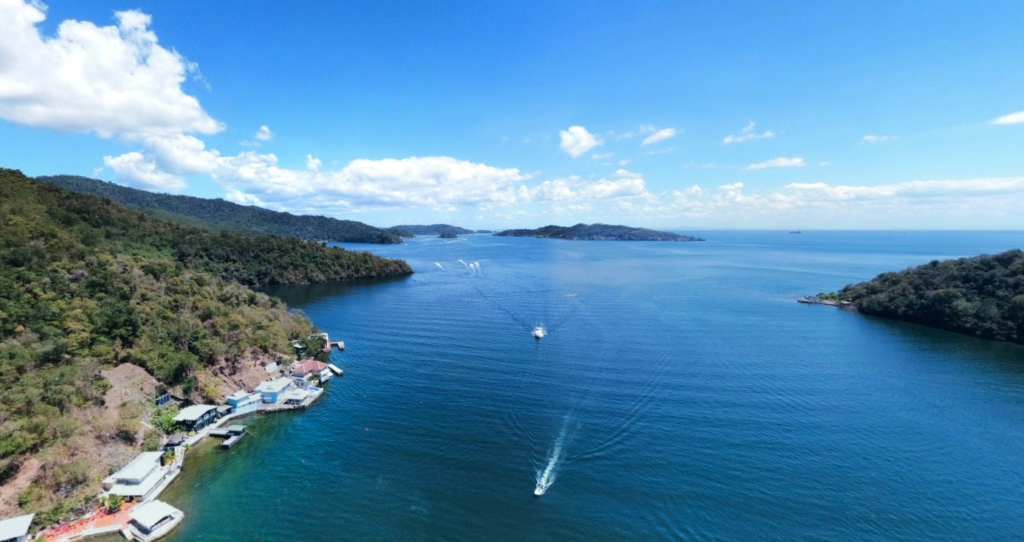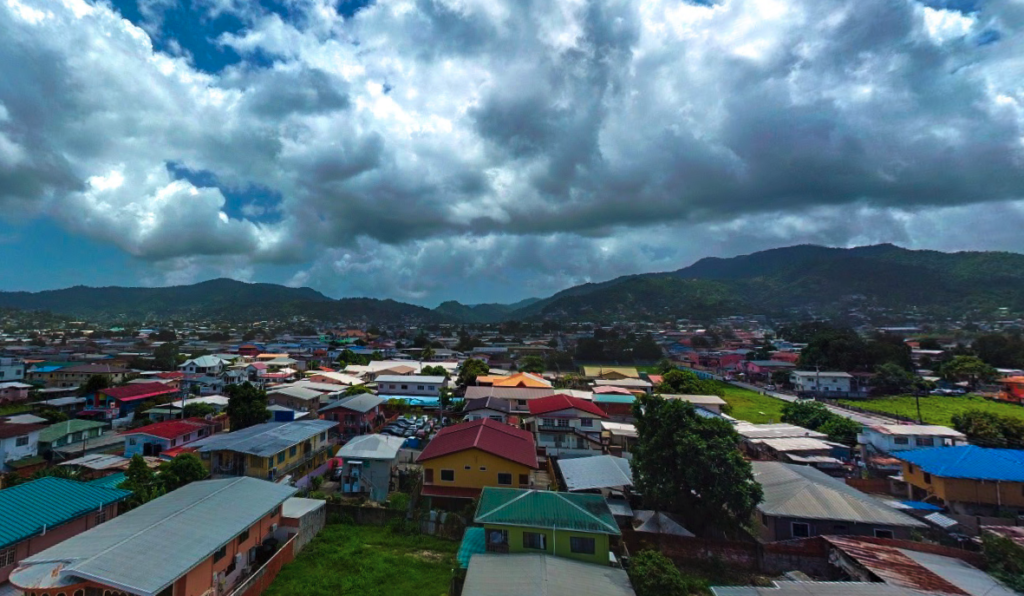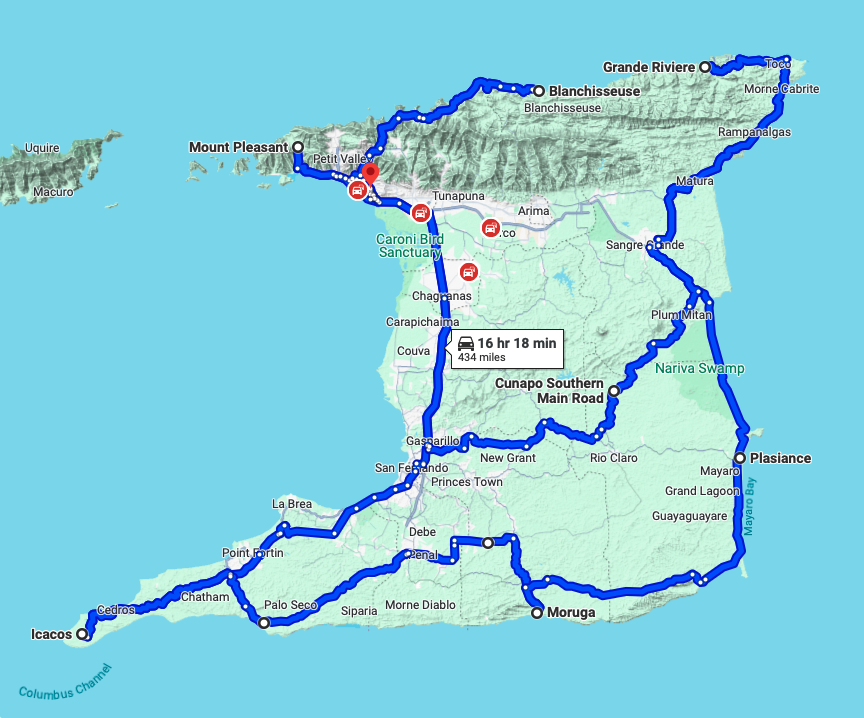Trinidad and Tobago / Republic of Trinidad and Tobago – Let’s explore here

What’s it like in Trinidad and Tobago?
Trinidad and Tobago consists of the two main islands and a set of 20 much smaller islands. The island of Trinidad is located not far (about 7 miles) from the coast of Venezuela. It’s a relatively small country, about half the size of North Yorkshire in England, UK. Trinidad is approximately 50 miles (80 km) long and 37 miles (60 km) wide and Tobago is around 25 miles (40 km) long by 7½ miles (12 km) wide.
In the north of Trinidad lies a small mountain range called Northern Range. The rest of Trinidad is coved with a plateau. Tobago also has a mountain range covering the east of the island. The highest point is El Cerro del Aripo, at 3,080 ft (940 m) above sea level – which is in Trinidad.
Trinidad and Tobago’s population is around 1½ million (2022) and its capital, Port of Spain, is home to around 37,000 people. Due to its oil reserves, the country doesn’t rely on tourism like many other Caribbean islands.

A bit about the history of Trinidad and Tobago
Early History and European Exploration
Trinidad and Tobago were originally inhabited by indigenous peoples, including the Arawak and Carib tribes. Christopher Columbus arrived in Trinidad in 1498 during his third voyage to the Americas, and the islands were subsequently claimed by Spain. Tobago was less affected by Spanish colonisation and was frequently contested by European powers.
Spanish Colonisation
The Spanish established control over Trinidad in the early 16th century, though the island’s indigenous population was decimated by disease and European settlement. Tobago was claimed by Spain but saw little Spanish presence. Over time, Spain focused its efforts on other colonies, leaving both islands relatively underdeveloped during the colonial period.
French and British Control
In the 18th century, both Trinidad and Tobago came under French and British influence. The French established a stronger presence in Trinidad during the late 18th century, but after the Treaty of Paris in 1763, the island was ceded to Britain. Tobago changed hands several times between the French, British and Dutch due to its strategic location and sugar plantations. By 1814, Tobago was fully under British control.
Slavery and Sugar Economy
The British relied heavily on enslaved Africans to work on the sugar plantations, especially in Trinidad and Tobago. The abolition of slavery in 1834 brought major changes to the islands’ economy, though indentured labourers from India were brought to the islands to work on plantations in the following decades, especially in Trinidad. This led to significant demographic shifts and the development of a diverse society.
Path to Self Government
Trinidad and Tobago gradually moved towards self governance in the 20th century. In 1925, the islands were granted limited self government, with an elected Legislative Council. In 1945, the islands achieved universal suffrage, and by the late 1950s, Trinidad and Tobago was granted full internal self government as part of the British Caribbean Federation.
Independence
On 31 August 1962, Trinidad and Tobago gained full independence from the United Kingdom. The country became a republic within the Commonwealth, with its first Prime Minister being Eric Williams. Williams played a key role in shaping the nation’s early years and is considered the ‘Father of the Nation’.
Republic Status
In 1976, Trinidad and Tobago became a republic, abolishing the monarchy and adopting a presidential system. The country’s political landscape has been shaped by competition between major political parties, notably the People’s National Movement and the United National Congress.
Modern Trinidad and Tobago
Trinidad and Tobago has developed into one of the more economically advanced nations in the Caribbean, with a diversified economy driven by oil, natural gas and manufacturing industries. Tourism also plays a key role, with the country known for its vibrant culture, including the famous Carnival festival. The country faces challenges such as inequality, crime and environmental concerns, but it remains a stable democracy in the region.

Trinidad and Tobago road trip
Trinidad and Tobago is our fourth planned stop on our road trip through the islands of the Caribbean. Having explored Bonaire, our next stop is Barbados.
Travelling overland between the islands is quite prohibitive due to the lack of transportation options. Travelling between different island countries via ferry is possible, however, ferries only operate between some islands. Chartering private boats between islands is also possible, although travelling with a car in this way is prohibitive. Flying is another option, although again, flights only operate between some islands.
Map of our road trip around the island of Trinidad

This is a map of our planned route around the island of Trinidad, starting and ending in the capital, Port of Spain.
Map of our road trip around the island of Tobago

This is a map of our planned route around the island of Tobago, starting and ending in the port of Scarborough.
Weather in Trinidad and Tobago
When is the best time to visit Trinidad and Tobago?
The best time to visit Trinidad and Tobago is from January to April. During these months, the islands have 8 hours of sunshine per day and rainfall of 1.9 – 2.3 inches (49 – 58mm) per month. The temperature is pretty constant at 29 – 30°C (84 – 86°F) during the day, and 21 – 23°C (70 – 73°F) during the night.
When is the worst time to visit Trinidad and Tobago?
The worst time to visit Trinidad and Tobago is from May to November. During these months, humidity rises and the islands have rain 19 – 23 days per month, with averages of 6.4 – 9.1 inches (163 – 230mm) per month. The temperature is pretty constant at 29 – 30°C (84 – 86°F) during the day, and 21 – 23°C (70 – 73°F) during the night.
Hurricane Season in the Caribbean
Hurricane season in the Caribbean runs from June 1 to November 30. Storms tend to be more frequent and more severe in the latter half of the season.
Hurricanes are least likely during December, January and February.
Travel in and around Trinidad and Tobago
Travelling between Trinidad and Tobago by ferry
Ferries travel between the islands every day except Saturdays and bank holidays, via the Trinidad and Tobago inter-island transportation company. The ferries leave from Port of Spain in Trinidad and Scarborough in Tobago. Ferries that transport vehicles take around 7 hours each way, and the faster ferries for foot passengers take around 3 hours each way.
Travelling to Trinidad and Tobago from Venezuela by ferry
There used to be a weekly car ferry travelling between La Guiria in Venezuela and Chaguaramas in Trinidad and Tobago. However the company stopped operating some years ago, and they no longer have a website, nor respond to messages (2024). It is possible to charter a boat from Venezuela, else flying is another option.
Ferries to other Caribbean islands from Trinidad and Tobago
There are currently no ferries to other island countries in the Caribbean from Trinidad and Tobago (2024).
What’s it like to drive in Trinidad and Tobago?
They drive on the left hand side of the road in Trinidad and Tobago. Car hire is available in both Trinidad and Tobago and roads are, in the main, well maintained. There are minor roads to bays and coves however that are not maintained and in poor condition.
We’ve also created a dedicated page to driving abroad, which you might find helpful 🙂
What currency do they use in Trinidad and Tobago?
In Trinidad and Tobago they use the Trinidad and Tobago dollar. Cash is widely used. The use of credit / debit cards is widely accepted in major cities, although not in rural areas. Travellers cheques are not accepted in the main. There are ATMs in cities, although not all accept foreign issued cards.
You should make yourself aware of the amount that your bank charges you for using credit and debit cards abroad. Often credit cards are cheaper for purchasing items directly, and for withdrawing cash from ATMs.
What language do they speak in Trinidad and Tobago?
They speak English and Creole in Trinidad and Tobago. English is spoken in tourist areas.
What time zone is Trinidad and Tobago in?
Remember, when you’re planning your next trip to take a look at what time zone it’s in.
Do I need a visa to visit Trinidad and Tobago?
We’ve created a dedicated, more comprehensive page on visas, which you should find helpful. Check it out!
Is wild camping legal in Trinidad and Tobago?
No, wild camping is not widely accepted in Trinidad and Tobago.
What plug / socket type do they use in Trinidad and Tobago?
In Trinidad and Tobago they use plug / socket types A and B.


Health issues in Trinidad and Tobago
Is it safe to drink water in Trinidad and Tobago?
Yes, it is safe to drink tap water in Trinidad and Tobago. Bottled water is also readily available across the country.
What vaccinations are required for Trinidad and Tobago?
This NHS website is kept up to date with all relevant information on vaccinations in Trinidad and Tobago.
Phones in Trinidad and Tobago
What is the country calling code for Trinidad and Tobago?
The country calling code for Trinidad and Tobago is +1 868
What are the emergency phone numbers in Trinidad and Tobago?
- The emergency number for police in Trinidad and Tobago is: 999 / 911
- In Trinidad and Tobago, the emergency number for ambulance is: 811
- The emergency number for fire in Trinidad and Tobago is: 990
If you’ve got some useful info that you’d like to share, let us know!
And don’t forget to check out all the other pictures!
